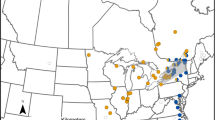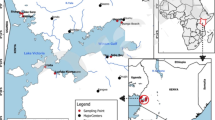Abstract
Many Oreochromis species utilized in aquaculture were extensively introduced outside their native range in Africa. Given their recent evolutionary radiation, these species hybridize easily, posing a threat to the integrity of local adaptation. The objective of this work was to study the genetic diversity of the Mozambique tilapia (Oreochromis mossambicus) in its native range, southern Africa, and provide a method for identifying hybrids with genetic markers. We genotyped the mitochondrial DNA (mtDNA) control region (385 bp) of wild and farmed O. mossambicus, wild and farmed O. niloticus and morphologic wild hybrids. These data were complemented with published sequences of parapatric and sympatric Oreochromis taxa. Phylogeographic analysis showed the presence of two O. mossambicus lineages, the southernmost representing a recent Holocene radiation. Hybridization of O. mossambicus was indicated by the presence of O. niloticus and O. mortimeri–andersonii mtDNA specimens in the Limpopo basin and of O. karongae mtDNA in specimens from Malawi. We also genotyped seven suspected hybrid individuals from the Limpopo River, and 137 wild and farmed Mozambique and Nile tilapia samples with five microsatellite markers. Factorial Component Analysis, Bayesian clustering and assignment analyses consistently delineated an O. mossambicus and an O. niloticus group, with the putative hybrids positioned in between. Different levels of hybridization were detected by the Bayesian assignment. The complex nature of hybridization and introgression between cichlid species raises major concerns for the long-term integrity of Mozambique tilapia.
Similar content being viewed by others
References
Allendorf FW, Leary RF, Spruell P, Wenburg JK (2001) The problems with hybrids: setting conservation guidelines. TREE 16:613–622
Bandelt HJ, Forster P, Rohl A (1999) Median-joining networks for inferring intraspecific phylogenies. Mol Biol Evol 16:37–48
Barton NH (2001) The role of hybridization in evolution. Mol Ecol 10:551–568
Beerli P (2004) Effect of unsampled populations on the estimation of population sizes and migration rates between sampled populations. Mol Ecol 13:827–836
Belkhir K (1999) GENETIX, logiciel sous WindowsTM pour la génétique des populations. Laboratoire Génome et Populations, Université de Montpellier II. http://www.univ-montp2.fr/∼genetix
Bernatchez L, Guyomard R, Bonhomme F (1992) DNA sequence variation of the mitochondrial control region among geographically and morphologically remote European brown trout Salmo trutta populations. Mol Ecol 1:161–173
Cassens I, Van Waerebeek K, Best PB, Crespo EA, Reyes J, Milinkovitch MC (2003) The phylogeography of dusky dolphins (Lagenorhynchus obscurus): a critical examination of network methods and rooting procedures. Mol Ecol 12:1781–1792
Crandall KA, Bininda-Emonds ORP, Mace GM, Wayne RK (2000) Considering evolutionary processes in conservation biology. TREE 15:290–295
Dollar ESJ (1998) Palaeofluvial geomorphology in southern Africa: a review. Prog Phys Geog 22:325–349
Evanno G, Regnaut S, Goudet J (2005) Detecting the number of clusters of individuals using the software STRUCTURE: a simulation study. Mol Ecol 14:2611–2620
Falk TM, Teugels GG, Abban EK, Villwock W, Renwrantz L (2003) Phylogeographic patterns in populations of the black-chinned tilapia complex (Teleostei, Cichlidae) from coastal areas in West Africa: support for the refuge zone theory. Mol Phylogenet Evol 27:81–92
Gillmore KS (1978) A fisheries survey of Shashe Dam, Botswana. Unpublished report of the Department of Agriculture and Fisheries, Ministry of Agriculture, Gaborone Botswana, p 26
Goodman SJ (1997) Rst Calc: a collection of computer programs for calculating estimates of genetic differentiation from microsatellite data and a determining their significance. Mol Ecol 6:881–885
Gregg RE, Howard JH, Shonhiwa F (1998) Introgressive hybridization of tilapias in Zimbabwe. J Fish Biol 52:1–10
Goudet J (2001) FSTAT, a program to estimate and test gene diversities and fixation indices (version 2.9.3). Update from Goudet 1995. Available from http://www.unil.ch/izea/softwares/fstat.html.
Guo SW, Thompson EA (1992) Performing the exact test of Hardy–Weinberg proportions for multiple alleles. Biometrics 48:361–372
Hall TA (1999) BioEdit: a user-friendly biological sequence alignment editor and analysis program for Windows 95/98/NT. Nucl Acids Symp Ser 41:95–98
Hey J, Won Y-J, Sivasundar A, Nielsen R, Market JA (2004) Using nuclear haplotypes with microsatellites to study gene flow between recently separated Cichlid species. Mol Ecol 13:909–919
Joyce D, Lunt DH, Bills R, Turner GF, Katongo C, Duftner N, Sturmbauer C, Seehausen O (2005) An extant fish radiation␣emerged in an extinct Pleistocene Lake. Nature 435:90–94
Klett V, Meyer A (2002) What, if anything, is a Tilapia? Mitochondrial ND2 phylogeny of Tilapiines and the evolution of parental care system in the African cichlid fishes. Mol Biol Evol 19:865–883
Kleynhans CJ, Hoffman A (1993) First record of Oreochromis macrochir (Boulenger, 1912) (Pisces: Cichlidae) from the Limpopo River in South Africa. SAJ Aquat Sci 18:104–107
Kocher TD (2004) Adaptive evolution as explosive radiation: the cichlid fish model. Nature Rev Genet 5:288–298
Kumar S, Tamura K, Jakobsen IB, Nei M (2001) MEGA2: Molecular Evolutionary Genetics Analysis software. Bioinformatics 17:1244–1245
Lee BY, Lee WJ, Streelman JT, Carleton KL, Howe AE, Hulata G, Slettan A, Stern JE, Terai Y, Kocher TD (2005) A second-generation genetic linkage map of tilapia (Oreochromis spp.). Genetics 170:237–244
Lee WJ, Kocher TD (1996) Microsatellite DNA markers for genetic mapping in the tilapia, Oreochromis niloticus. J Fish Biol 49:169–171
Meyer A, Kocher TD, Basasibwaki P, Wilson AC (1990) Monophyletic origin of lake Victoria cichlid fishes suggested by mitochondrial-DNA sequences. Nature 347:550–553
Moralee RD, Van der Bank FH, Van der Waal BCW (2000) Biochemical genetic markers to identify hybrids between the endemic Oreochromis mossambicus and the alien species, O. niloticus (Pisces: Cichlidae). Water SA 26:263–268
Nagl S, Tichy H, Mayer WE, Samonte IE, McAndrew BJ, Klein J (2001) Classification and phylogenetic relationships of African tilapiine fishes inferred from mitochondrial DNA sequences. Mol Phylogenet Evol 20:361–374
Nagl S, Tichy H, Mayer WE, Takezaki N, Takahata N, Klein J (2000) The origin and age of haplochromine fishes in Lake Victoria, East Africa. Proc R Soc Lond B Biol Sci 267:1049–1061
Nei M (1987) Molecular evolutionary genetics. Columbia University Press, New York
Posada D, Crandall KA (1998) Modeltest: testing the model of DNA substitution. Bioinformatics 14:817–818
Pritchard JK, Stephens M, Donnelly P (2000) Inference of population structure using multilocus genotype data. Genetics 155:945–959
Raymond M, Rousset F (1995) GENEPOP (version 1.2): a population genetics software for exact tests and ecumenicism. J Hered 86:248–249
Rognon X, Guyomard R (2003) Large extent of mitochondrial DNA transfer from Oreochromis aureus to O-niloticus in West Africa. Mol Ecol 12:435–445
Romana-Eguia MRR, Ikeda M, Basiao ZU, Taniguchi N (2004) Genetic diversity in farmed Asian Nile and red hybrid tilapia stocks evaluated from microsatellite and mitochondrial DNA analysis. Aquaculture 236:131–150
Salzburger C, Baric S, Sturmbauer C (2002) Speciation via introgressive hybridization in East African cichlids? Mol Ecol 11:619–625
Schmidt HA, Strimmer K, Vingron M, von Haeseler A (2002) TREE-PUZZLE: maximum likelihood phylogenetic analysis using quartets and parallel computing. Bioinformatics 18:502–504
Schwank EJ (1995) The introduced Oreochromis niloticus is spreading on the Kafue floodplain, Zambia. Hydrobiologia 315:143–147
Seehausen O (2004) Hybridization and adaptive radiation. TREE 19:198–207
Seehausen O, Koetsier E, Schneider MV, Chapman LJ, Chapman CA, Knight ME, Turner GF, van Alphen JJM, Bills R (2003) Nuclear markers reveal unexpected genetic variation and a Congolese-Nilotic origin of the Lake Victoria cichlid species flock. Proc R Soc Lond B 270:129–137
Skelton P (1993) A complete guide to the freshwater fishes of Southern Africa. Southern Book Publishers, Halfway House, Harare
Skelton P (2001) A complete guide to the freshwater fishes of Southern Africa. Struik, Cape Town
Slatkin M (2005) Seeing ghosts: the effect of unsampled populations on migration rates estimated for sampled populations. Mol Ecol 14:67–73
Stewart KM (2001) The freshwater fish of Neogene Africa (Miocene–Pleistocene): systematics and biogeography. Fish Fisheries 2:177–230
Sturmbauer C, Baric S, Salzburger W, Rüber L, Verheyen E (2001) Lake level fluctuations synchronize genetic divergences of cichlid fishes in African Lakes. Mol Biol Evol 18:144–154
Tamura K, Nei M (1993) Estimation of the number of nucleotide substitutions in the control region of mitochondrial DNA in humans and chimpanzees. Mol Biol Evol 10:512–526
Trewavas E (1983) Tilapiine fishes of the genera Sarotherodon, Oreochromis and Danakilia. Cornell University Press, Ithaca New York, p 583
Turner GF (2003) Oreochromis (Nyasalapia) karongae (Trewavas). http://malawicichlids.com/mw10001a.htm. In: “The Cichlid Fishes of Lake Malawi, Africa” (M. K. Oliver, webmaster), http://malawicichlids.com. Accessed September 2005
Tweddle D, Willoughby NG (1979) Part 2: An annotated checklist of the fish fauna of the river Shire south of Kapachira Falls, Malawi. Ichthyol Bull JLB Smith Inst Ichthyol 39:10–12
Tweddle D, Lewis DSC (1979) Part1: the nature of the barrier separating the Lake Malawi and Zambezi fish faunas. Ichthyol Bull JLB Smith Instit Ichthyol 39:1–9
Van Houdt JKJ, Pinceel J, Flamand M-C, Briquet M, Dupont E, Volkaert FAM, Baret PV (2005) Migration barriers protect indigenous brown trout (Salmo trutta) population from introgressions with stocked hatchery fish. Conserv Genet 6:175–191
Van der Waal BCW, Bills R (2000) Oreochromis niloticus (Teleostei: Cichlidae) now in the Limpopo River System. S Afr J Sci 96:47–48
Waples RS, Gaggiotti O (2006) What is a population? An empirical evaluation of some genetic methods for identifying the number of gene pools and their degree of connectivity. Mol Ecol 15:1419–1439
Weir BS, Cockerham CC (1984) Estimating F-statistics for the analysis of population structure. Evolution 38:1358–1370
Welcomme R (1967) Observations on the biology of the introduced species of Tilapia in Lake Victoria. Revue Zool Bot Afr 76:249–279
Wohlfarth GW, Hulata GI (1981) Applied genetics of tilapias. ICLARM Stud Rev 6:1–26
Yang ZH (1994) Maximum likelihood phylogenetic estimation from DNA sequences with variable rates over sites: approximate methods. J Mol Evol 39:306–314
Acknowledgements
This project was funded by the Department of International Development (DFID, UK) and benefited from a Bilateral Scientific Cooperation Grant between the Republic of South Africa—Flanders (Belgium) (Project BIL/00/30). H. Heyns of the farm Samaria is sincerely thanked for permission to collect samples, and G. Maes, D.␣Tweddle, J. Snoeks, two anonymous reviewers and Editor␣E. Nielsen for providing useful comments on the manuscript. We also thank N. Leat for critically reading the manuscript.
Author information
Authors and Affiliations
Corresponding author
Appendices
Appendices
Rights and permissions
About this article
Cite this article
D’Amato, M.E., Esterhuyse, M.M., van der Waal, B.C. et al. Hybridization and phylogeography of the Mozambique tilapia Oreochromis mossambicus in southern Africa evidenced by mitochondrial and microsatellite DNA genotyping. Conserv Genet 8, 475–488 (2007). https://doi.org/10.1007/s10592-006-9186-x
Received:
Accepted:
Published:
Issue Date:
DOI: https://doi.org/10.1007/s10592-006-9186-x




